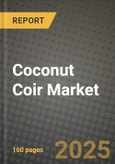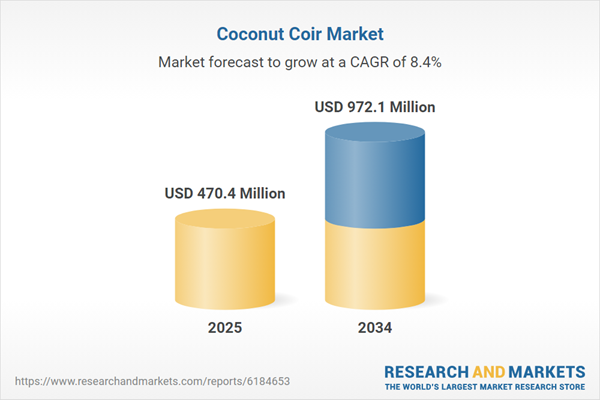Coconut Coir Market
The coconut coir market encompasses value-added products derived from the husk - long fibre, short fibre (tow), pith/peat, and chips - processed into horticultural substrates, erosion-control mats and logs, geotextiles, mattresses and upholstery, brushes and doormats, packaging, and emerging bio-composites. Adoption is strongest in protected cultivation and hydroponics, where buffered coir slabs, grow-bags, and cubes replace or augment peat and mineral wool. In landscaping and civil works, needle-punched coir mats and stitched logs stabilize slopes and shorelines while meeting biodegradability mandates. Latest trends include precision-graded particle blends for crop-specific water-air ratios, low-EC desalination and calcium/magnesium buffering, near-shored mixing plants for custom blends, and digitized traceability from farm cluster to bale. Demand is driven by the expansion of controlled-environment agriculture, water-scarcity resilience, ESG-aligned material choices in infrastructure, and circular use of by-products from coconut processing. The competitive landscape spans integrated exporters in South and Southeast Asia and specialized converters near end-markets; differentiation hinges on consistency (EC/pH/PSD), certifications, wash technology, and supply reliability through monsoon seasons and logistics cycles. Buyers increasingly evaluate total system performance - root health, crop turns, and labour efficiency - over substrate cost alone, while construction and municipal buyers prioritize verified biodegradation and mechanical endurance of geotextiles. Strategic partnerships between growers, substrate brands, and greenhouse integrators are common, with co-development of crop recipes and after-sales agronomy. Looking ahead, coir’s role expands via hybrid blends (coir-wood fibre, coir-perlite), bio-composite panels, moulded packaging, and low-carbon accounting, positioning the category as a mainstream, high-spec natural material rather than a commodity by-product.Coconut Coir Market Key Insights
- Horticulture substrates become the growth engine
- From peat alternative to performance material
- Quality is defined by chemistry and particle science
- Geotextiles align with green infrastructure
- Near-shoring and custom blending reduce volatility
- End-to-end traceability and certification matter
- Mechanization and labour efficiency in greenhouses
- Product diversification beyond agriculture
- Risk management around climate and logistics
- Data-driven agronomy as a service
Coconut Coir Market Reginal Analysis
North America
Greenhouse expansion and water-efficient cultivation propel demand for buffered grow-bags and custom blends aligned to regional water chemistry. Retail and municipal sustainability goals support coir geotextiles in erosion-control projects. Near-shored blending and warehousing improve responsiveness, while large growers demand certifications, lot traceability, and agronomic after-sales support.Europe
Environmental regulations and peatland conservation accelerate substitution toward coir and hybrid substrates. Precision agriculture drives tight COA tolerances for EC/pH and particle gradation. Infrastructure projects favour biodegradable natural-fiber mats that meet EN performance criteria. Seasonality is offset by multi-origin sourcing and regional mixing hubs close to cluster greenhouses.Asia-Pacific
Origin markets lead in fibre extraction and washing technologies, with integrated exporters serving global horticulture brands. Rapid growth in protected cultivation across Australia, Japan, and parts of Southeast Asia boosts demand for high-spec substrates. Domestic infrastructure uses coir geotextiles for flood and shoreline resilience, while mattress and brush segments sustain steady base-load demand.Middle East & Africa
Arid-zone agriculture values coir’s water-retention and root aeration characteristics in high-salinity contexts, provided rigorous buffering is guaranteed. Government-backed greenhouse programs and landscape rehabilitation spur uptake. Logistics reliability, heat-resistant packaging, and local technical support are decisive, particularly for large produce clusters.South & Central America
Emerging high-tech greenhouses and berry projects adopt coir blends to stabilize yields under variable climates. Public works incorporate natural-fiber erosion solutions along roads and waterways. Importers prioritize compressed master bales, flexible lead times, and post-hydration training to ensure uniform expansion and rapid crop establishment.Coconut Coir Market Segmentation
By Product
- Buffering Coconut Coir
- Bristle Coconut Coir
By Type
- Brown Fibre
- White Fibre
By Application
- Netting
- Upholstery-mattresses
- Bedding and Flooring
- Garden
- Packaging
- Others
By End-User
- Agriculture
- Packaging
- Construction & Building
- Others
Key Market players
Hayleys Fibre PLC, Lanka Coco Products (Pvt) Ltd, Coco Green (UK) Ltd, RIOCOCO, Dutch Plantin, Pelemix Ltd, Enkev Group, Galuku Group Limited, Jiffy Group, FibreDust LLC, Growrite Substrates (Ceyhinz Link International), SMS Exporters, Allwin Coir, Coir Green (Pvt) Ltd, Premier Coir Products (Pvt) Ltd.Coconut Coir Market Analytics
The report employs rigorous tools, including Porter’s Five Forces, value chain mapping, and scenario-based modelling, to assess supply-demand dynamics. Cross-sector influences from parent, derived, and substitute markets are evaluated to identify risks and opportunities. Trade and pricing analytics provide an up-to-date view of international flows, including leading exporters, importers, and regional price trends.Macroeconomic indicators, policy frameworks such as carbon pricing and energy security strategies, and evolving consumer behaviour are considered in forecasting scenarios. Recent deal flows, partnerships, and technology innovations are incorporated to assess their impact on future market performance.
Coconut Coir Market Competitive Intelligence
The competitive landscape is mapped through proprietary frameworks, profiling leading companies with details on business models, product portfolios, financial performance, and strategic initiatives. Key developments such as mergers & acquisitions, technology collaborations, investment inflows, and regional expansions are analyzed for their competitive impact. The report also identifies emerging players and innovative startups contributing to market disruption.Regional insights highlight the most promising investment destinations, regulatory landscapes, and evolving partnerships across energy and industrial corridors.
Countries Covered
- North America - Coconut Coir market data and outlook to 2034
- United States
- Canada
- Mexico
- Europe - Coconut Coir market data and outlook to 2034
- Germany
- United Kingdom
- France
- Italy
- Spain
- BeNeLux
- Russia
- Sweden
- Asia-Pacific - Coconut Coir market data and outlook to 2034
- China
- Japan
- India
- South Korea
- Australia
- Indonesia
- Malaysia
- Vietnam
- Middle East and Africa - Coconut Coir market data and outlook to 2034
- Saudi Arabia
- South Africa
- Iran
- UAE
- Egypt
- South and Central America - Coconut Coir market data and outlook to 2034
- Brazil
- Argentina
- Chile
- Peru
Research Methodology
This study combines primary inputs from industry experts across the Coconut Coir value chain with secondary data from associations, government publications, trade databases, and company disclosures. Proprietary modeling techniques, including data triangulation, statistical correlation, and scenario planning, are applied to deliver reliable market sizing and forecasting.Key Questions Addressed
- What is the current and forecast market size of the Coconut Coir industry at global, regional, and country levels?
- Which types, applications, and technologies present the highest growth potential?
- How are supply chains adapting to geopolitical and economic shocks?
- What role do policy frameworks, trade flows, and sustainability targets play in shaping demand?
- Who are the leading players, and how are their strategies evolving in the face of global uncertainty?
- Which regional “hotspots” and customer segments will outpace the market, and what go-to-market and partnership models best support entry and expansion?
- Where are the most investable opportunities - across technology roadmaps, sustainability-linked innovation, and M&A - and what is the best segment to invest over the next 3-5 years?
Your Key Takeaways from the Coconut Coir Market Report
- Global Coconut Coir market size and growth projections (CAGR), 2024-2034
- Impact of Russia-Ukraine, Israel-Palestine, and Hamas conflicts on Coconut Coir trade, costs, and supply chains
- Coconut Coir market size, share, and outlook across 5 regions and 27 countries, 2023-2034
- Coconut Coir market size, CAGR, and market share of key products, applications, and end-user verticals, 2023-2034
- Short- and long-term Coconut Coir market trends, drivers, restraints, and opportunities
- Porter’s Five Forces analysis, technological developments, and Coconut Coir supply chain analysis
- Coconut Coir trade analysis, Coconut Coir market price analysis, and Coconut Coir supply/demand dynamics
- Profiles of 5 leading companies - overview, key strategies, financials, and products
- Latest Coconut Coir market news and developments
Additional Support
With the purchase of this report, you will receive:- An updated PDF report and an MS Excel data workbook containing all market tables and figures for easy analysis.
- 7-day post-sale analyst support for clarifications and in-scope supplementary data, ensuring the deliverable aligns precisely with your requirements.
- Complimentary report update to incorporate the latest available data and the impact of recent market developments.
This product will be delivered within 1-3 business days.
Table of Contents
Companies Mentioned
- Hayleys Fibre PLC
- Lanka Coco Products (Pvt) Ltd.
- Coco Green (UK) Ltd.
- RIOCOCO
- Dutch Plantin
- Pelemix Ltd.
- Enkev Group
- Galuku Group Limited
- Jiffy Group
- FibreDust LLC
- Growrite Substrates (Ceyhinz Link International)
- SMS Exporters
- Allwin Coir
- Coir Green (Pvt) Ltd.
- Premier Coir Products (Pvt) Ltd.
Table Information
| Report Attribute | Details |
|---|---|
| No. of Pages | 160 |
| Published | November 2025 |
| Forecast Period | 2025 - 2034 |
| Estimated Market Value ( USD | $ 470.4 Million |
| Forecasted Market Value ( USD | $ 972.1 Million |
| Compound Annual Growth Rate | 8.4% |
| Regions Covered | Global |
| No. of Companies Mentioned | 15 |









